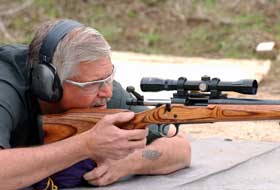Anyhow, Maeda postulates 10 Laws of Simplicity:
1) ReduceWell, that's about 6 laws too many...4 is cool...10 is complex...and Maeda does like his mumbo-jumbo a bit too much. But I've been thinking about his first 4 laws, and it occurs to me that they can and should be applied to self-defense training. I expecially like the concept of REDUCTION as defined as the balancing act between simple and complex:
2) Organize
3) Time
4) Learn
5) Differences
6) Context
7) Emotion
8) Trust
9) Failure
10) The One — simplicity is about subtracting the obvious and adding the meaningful
How simple can you make it
vs
How complex does it need to be
vs
How complex does it need to be
We're in an era of "branded" training, and part of the branding process is adding proprietary complexity. My classic example is the trainer who breaks the draw stroke into 8 or 9 separate components...in a real confrontation, you're on Step 4 when you get capped by a 'banger who just pulled out his piece and started blasting.
The 'banger's lack of full understanding of the mechanics of the draw wasn't a hindrance to blowing your sorry butt away.
When I taught more than I do now (which is, like, never) I used to start out by saying shooting was simple; those of us suffering from testosterone poisoning went to some lengths to make it complicated. The gun "wants" to shoot straight, and your job as the person holding the gun was to not get in its way.
It's an article of faith with me that analysis — the disassembly of an action into increasingly smaller component parts — can only get you so far. To go back to our example, if we continue our analysis of the draw stroke we'll probably find that it's made up of a lot more than 8 or 9 separate components. There's probably a thousand teeny-tiny muscular arrangements that make up a good draw stroke, and if we break them all down into the smallest controllable parts then analyze each individual part to minimize wasted motion, well, we'll get faster, won't we?
Here's where the balancing act comes in...
Do the Real World benefits to us outweight the negatives of adding complexity to the system?
In the case of the draw, no. Shaving hundredths of a second off a draw may well be a fine activity if you get sponsorship money from gun companies for winning matches, but in the Real World the time is best spent elsewhere.
Good food for thought!






5 comments:
MB,
Simple is as simple does. Don't talk. Shoot!
Have you hacked into my computer? I'm in the middle of a column on why the fast draw is almost meaningless for self defense.
Or, great minds do think alike.)
Walt
I know exactly what you mean. I can't count how many articles in gun mags that "teach" you the draw and just as you say, they try to show you 8 or 9 different movements to complete the draw. I mean hell, how flipping hard is it to draw a gun from a holster???? KISS!
I vaguely recall Chuck Taylor writing about the practice levels needed to acheive a 1.0 second reload for the single-column 1911 pistol. He did conceed that such capability was not likely meaningful outside the competitive environment.
Each student has a finite amount of time. Part of an instructor's duty is to help guide them into those activities that will yield the most meaningful returns.
- RSR
We really need to apply those to government, especially #1 and especially to the bats.
Post a Comment